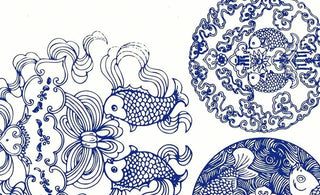
The fascinating history of Chinese decorative arts is a timeless journey, spanning thousands of years and encompassing a myriad of forms, techniques, and cultural influences.The roots of Chinese decorative arts can be traced back to the Neolithic period, with pottery and jade carving as some of the earliest forms. During the Shang and Zhou dynasties, the development of bronze casting led to significant advancements. Intricate bronze vessels, used both for ritualistic purposes and daily life, showcased early Chinese mastery in metallurgy and decorative motifs. This rich tapestry of artistry is not merely a chronicle of aesthetic evolution but a profound narrative of China's cultural, philosophical, and social dynamics through the ages.
The Magnificence of Chinese Porcelain
Various crafts and techniques unique to Chinese decorative arts, such as cloisonné, lacquer carving, jade carving, and silk embroidery, have been honed over centuries. Each craft demands a high level of skill and precision, making them revered art forms. Chinese porcelain, a marvel of artistic expression and technical skill, has enchanted the world for centuries. The history of Chinese porcelain stretches back thousands of years, with its origins rooted in the rich traditions of ancient China. Renowned for its delicate beauty and exquisite craftsmanship, Chinese porcelain holds a special place in the realm of decorative arts. The art of porcelain making in China dates back to the Tang Dynasty (618-907 AD), but it was during the Song Dynasty (960-1279 AD) that Chinese porcelain reached new heights of refinement and elegance. The Song Dynasty saw the development of iconic styles such as the serene celadon glazes and the famous blue and white porcelain. These intricate designs and masterful techniques continue to captivate collectors and enthusiasts to this day.
The Mastery of Lacquerware
Lacquerware, with its gleaming surfaces and intricate designs, represents another remarkable facet of Chinese decorative arts. The art of lacquerware can be traced back over two thousand years, with its origins deeply intertwined with Chinese culture and tradition. Lacquer, a natural resin derived from the sap of the lacquer tree, is meticulously applied in layers to create a durable and lustrous finish. Religious and philosophical beliefs, especially Taoism, Confucianism, and Buddhism, have significantly influenced Chinese decorative arts. These influences are evident in the representation of religious figures, mythological beings, and the use of religious symbols and scripts in art.Chinese artisans have perfected the technique of lacquerware, producing exquisite pieces that range from intricately carved boxes and screens to furniture and decorative objects.
The Grace of Chinese Calligraphy and Painting
Chinese calligraphy, often hailed as the highest form of visual art in Chinese culture, combines the elegance of brushwork with the power of written language. With a history spanning thousands of years, Chinese calligraphy is not only a means of communication but an art form that reflects the essence of Chinese philosophy and aesthetics. Each stroke of the brush in Chinese calligraphy carries meaning and intention, resulting in characters that possess a harmonious balance of form and expression. The art of calligraphy requires discipline, patience, and a deep understanding of the underlying principles of balance, rhythm, and composition. Chinese calligraphy is not merely writing; it is a dance of ink and brush on paper, creating a visual feast for the eyes. Chinese painting, an art form that has flourished for centuries, captures the beauty of the natural world and expresses the inner emotions of the artist. Rooted in Taoist and Buddhist philosophies, Chinese painting seeks to cultivate a sense of harmony, balance, and tranquility. Using brush and ink, Chinese painters depict landscapes, flora, fauna, and human figures with meticulous brushwork and a profound understanding of composition. The use of negative space, the play of light and shadows, and the delicate balance of colors evoke a sense of serenity and contemplation. Chinese painting invites viewers to immerse themselves in a world of beauty and introspection. Chinese silk, with its lustrous sheen and soft texture, has been used to create intricate tapestries, garments, and decorative items. The art of silk embroidery involves the use of fine threads and delicate stitches to create intricate patterns and designs. From elaborate dragon robes to exquisitely embroidered landscapes, Chinese silk and embroidery exemplify elegance and sophistication.
In conclusion, the history of Chinese decorative arts is a testament to the ingenuity, creativity, and cultural richness of the Chinese people. Today, Chinese decorative arts continue to evolve, retaining their distinct identity while adapting to contemporary trends. From ancient pottery to contemporary design, these arts continue to captivate and inspire, telling the enduring story of one of the world’s greatest civilizations.The global influence of these arts is undeniable, with Chinese motifs and design principles being embraced and reinterpreted in various forms worldwide. From the magnificence of Chinese porcelain to the grace of lacquerware, the poetry of calligraphy, the serenity of painting, and the elegance of silk and embroidery, each art form carries within it a timeless beauty that continues to inspire and captivate.























